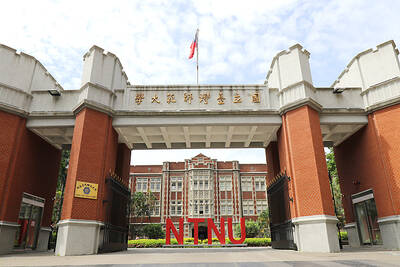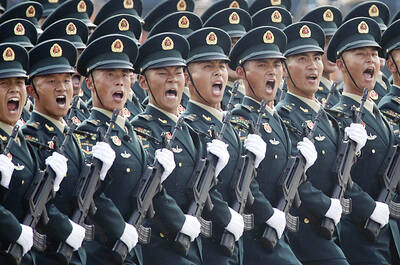China’s participation in the Rim of the Pacific (RIMPAC) military exercises might be improving Beijing’s ability to launch an invasion of Taiwan, a US expert said.
Reports from Honolulu said that a “big focus” of the naval maneuvers now under way is on how to land attack troops from amphibious ships and via helicopter.
“The American strategy of mil-mil [military-to-military] engagement with China is not only failing, it is a threat to US security interests,” said Richard Fisher, Asian military affairs expert at the International Assessment and Strategy Center.
“China is not going to change its path of aggression in the South China Sea or on the Taiwan Strait,” Fisher said.
“The insights it will gain from RIMPAC will only serve to improve its ability to impose imperialist control over the South China Sea and to better undertake a future military invasion of Taiwan,” he added.
Fisher said that this year’s RIMPAC exercise offered “a very disturbing” illustration of US patience-against-hope versus clear-cut Chinese aggression.
He said that during this year’s RIMPAC exercises, China’s People’s Liberation Army (PLA) could gain insights from the conduct of advanced amphibious assault operations by the US Navy’s latest and most modern landing helicopter dock (LHD) ship — the USS America.
“The PLA will likely be most grateful as they also intend to build their own LHD of similar size to the USS America,” Fisher said.
According to a report in the military newspaper Stars and Stripes, troops are this week practicing inflatable boat landings in the surf at Hawaii’s Kaneohe Bay and the US is demonstrating landings with 26-tonne amphibious assault vehicles.
A RIMPAC spokesman said that US Marines and the US’ “partner nations” had been busy since last week practicing getting on and off tilt-rotor Ospreys and CH-53E helicopters, and securing objectives, live-firing weapons and training at the shoreline.
Over the next few days, there are to be actual amphibious scenarios in which the Hawaiian islands will be used to represent fictitious countries in military operations.
A US Marine Corps spokesman said that the amphibious scenarios would include “forcible entry from the sea, flying forces off a ship.”

CHANGING LANDSCAPE: Many of the part-time programs for educators were no longer needed, as many teachers obtain a graduate degree before joining the workforce, experts said Taiwanese universities this year canceled 86 programs, Ministry of Education data showed, with educators attributing the closures to the nation’s low birthrate as well as shifting trends. Fifty-three of the shuttered programs were part-time postgraduate degree programs, about 62 percent of the total, the most in the past five years, the data showed. National Taiwan Normal University (NTNU) discontinued the most part-time master’s programs, at 16: chemistry, life science, earth science, physics, fine arts, music, special education, health promotion and health education, educational psychology and counseling, education, design, Chinese as a second language, library and information sciences, mechatronics engineering, history, physical education

The Chinese military has boosted its capability to fight at a high tempo using the element of surprise and new technology, the Ministry of National Defense said in the Quadrennial Defense Review (QDR) published on Monday last week. The ministry highlighted Chinese People’s Liberation Army (PLA) developments showing significant changes in Beijing’s strategy for war on Taiwan. The PLA has made significant headway in building capabilities for all-weather, multi-domain intelligence, surveillance, operational control and a joint air-sea blockade against Taiwan’s lines of communication, it said. The PLA has also improved its capabilities in direct amphibious assault operations aimed at seizing strategically important beaches,

New Taipei City prosecutors have indicted a cram school teacher in Sinjhuang District (新莊) for allegedly soliciting sexual acts from female students under the age of 18 three times in exchange for cash payments. The man, surnamed Su (蘇), committed two offenses in 2023 and one last year, the New Taipei District Prosecutors’ Office said. The office in recent days indicted Su for contraventions of the Child and Youth Sexual Exploitation Prevention Act (兒童及少年性剝削防制條例), which prohibits "engaging in sexual intercourse or lewd acts with a minor over the age of 16, but under the age of 18 in exchange for

The High Prosecutors’ Office yesterday withdrew an appeal against the acquittal of a former bank manager 22 years after his death, marking Taiwan’s first instance of prosecutors rendering posthumous justice to a wrongfully convicted defendant. Chu Ching-en (諸慶恩) — formerly a manager at the Taipei branch of BNP Paribas — was in 1999 accused by Weng Mao-chung (翁茂鍾), then-president of Chia Her Industrial Co, of forging a request for a fixed deposit of US$10 million by I-Hwa Industrial Co, a subsidiary of Chia Her, which was used as collateral. Chu was ruled not guilty in the first trial, but was found guilty